CANON INC. 30-2, Shimomaruko 3-chome, Ohta-ku, Tokyo 146-8501, Japan
U.S.A.
CANADA
EUROPE,
AFRICA &
MIDDLE EAST
CENTRAL &
SOUTH AMERICA
ASIA
OCEANIA
JAPAN
CANON U.S.A. INC.
For all inquiries concerning this camera, call toll free in the U.S.
1-800-OK-CANON or write to: Customer Relations, Canon U.S.A., Inc.
One Canon Plaza, Lake Success, N.Y. 11042-1198
CANON CANADA INC. HEADQUARTERS
6390 Dixie Road, Mississauga, Ontario L5T 1P7, Canada
CANON CANADA INC. MONTREAL BRANCH
5990, Côte-de-Liesse, Montréal Québec H4T 1V7, Canada
CANON CANADA INC. CALGARY OFFICE
2828, 16th Street, N.E. Calgary, Alberta T2E 7K7, Canada
For all inquiries concerning this camera, call toll free in Canada
1-800-OK-CANON
CANON EUROPA N.V.
Bovenkerkerweg 59-61, P.O. Box 2262, 1180 EG Amstelveen, The Netherlands
CANON COMMUNICATION & IMAGE FRANCE S.A.
102, Avenue du Général de Gaulle 92257 La Garenne-Colombes Cedex, France
CANON UK LTD.
Woodhatch Reigate Surrey RH2 8BF, United Kingdom
CANON DEUTSCHLAND GmbH
Europark Fichtenhain A10, 47807 Krefeld, Germany
CANON ITALIA S.p.A.
Palazzo L, Strada 6, 20089 Rozzano, Milanofiori, Milano, Italy
CANON Benelux N.V./S.A.
Bessenveldstraat 7, 1831 Diegem (Machelen), Belgium
CANON Schweiz AG
Geschäftsbereich Wiederverkauf, Industriestrasse 12, CH-8305 Dietlikon, Switzerland
CANON G. m. b. H.
Oberlaaerstrasse 233, 4th floor, 1100 Wien, Austria
CANON España, S. A.
C/Joaquín Costa, 41, 28002 Madrid, Spain
SEQUE Soc. Nac. de Equip., Lda.,
Praça da Alegria, 58, 2°, 1269-149 Lisboa, Portugal
CANON LATIN AMERICA, INC. DEPTO DE VENTAS
703 Waterford Way Suite 400 Miami, FL 33126 U.S.A.
CANON LATIN AMERICA, INC. CENTRO DE SERVICIO Y REPARACION
Apartado 2019, Zona Libre de Colón, República de Panamá
CANON HONGKONG CO., LTD.
9/F, The Hong Kong Club Building, 3A Chater Road, Central, Hong Kong
CANON SINGAPORE PTE. LTD.
79 Anson Road #09-01/06 Singapore 079906
CANON AUSTRALIA PTY. LTD.
1 Thomas Holt Drive, North Ryde, N.S.W. 2113, Australia
CANON NEW ZEALAND LTD.
Fred Thomas Drive, P.O. Box 33-336, Takapuna, Auckland, New Zealand
CANON SALES CO., INC.
12-15 Mita, 3-Chome, Minato-ku, Tokyo 108-8011, Japan
INSTRUCTIONS
I
N
S
T
R
U
C
T
O
N
S
I
This Instructions booklet is current as of January 2002. For information on using the
camera with system accessories introduced after this date, contact your nearest Canon
Service Center.
CT1-1232-001
© CANON INC. 2002
PRINTED IN JAPAN
Be sure to read these Instructions before using
your camera for the first time. Keep this booklet
handy for easy reference.
E
E
English Edition
�
Thank you for purchasing this Canon product
The EOS D60 digital camera is a high-performance, single-lens reflex AF camera with an ultra-
fine CMOS sensor having approx. 6.3 million effective pixels. The camera is compatible with all
Canon EF lenses and designed for quick and easy shooting. It is full-featured for all types of
photography, from fully automatic snapshooting to professional-level, creative work.
CompactFlash cards (CF Type I and II) serve as the recording medium.
Before using the camera, be sure to read these Instructions to familiarize yourself with the
camera’s features and proper operation.
∗ Using CF cards made by Canon is recommended.
Radio and Television Interference (VCCI Statement)
This camera is an information technology device that does not exceed Class B limits for
electromagnetic interference (EMI) in compliance with standards set by Japan’s Voluntary
Control Council for Interference by Information Technology Equipment (VCCI). This device may
still cause interference with radio or television reception when placed near such an appliance.
Read these Instructions to learn how to avoid reception interference of other appliances.
Test the Camera Before Shooting
Before using the camera, be sure to test it first. Check that the images are properly recorded
on the CF card. If the camera or CF card is faulty and the images cannot be recorded or read
by a personal computer, Canon cannot be held liable for any loss or inconvenience caused.
About Copyrights
Copyright laws in your country may prohibit the use of images of people and certain subjects
for anything but private enjoyment. Photographing public performances or exhibitions may
also be prohibited.
● Canon and EOS are trademarks of Canon Inc.
● Adobe and Photoshop are trademarks of Adobe Systems Incorporated.
● CompactFlash is a trademark of SanDisk Corporation.
IBM PC/AT and Microdrive are trademarks or registered trademarks of International
Business Machines.
● Macintosh is a registered trademark of Apple Corporation in the United States and other
countries.
● All other trademarks are the property of their respective owners.
This digital camera supports Exif 2.2 (also called “Exif Print”). Exif Print is a standard for
enhancing the communication between digital cameras and printers. By connecting to an Exif
Print-compliant printer, the camera’s image data at the time of shooting is used and optimized,
yielding extremely high quality prints.
Index
L
Q
Landscape Mode .................................... 45
Language .............................................. 121
LCD brightness ..................................... 120
LCD panel ......................................... 10, 16
LCD panel Illumination ............................ 67
Lens ........................................................ 27
M
Macro Flash .......................................... 138
Main Dial ........................................... 20, 30
Manual .................................................... 74
Manual focus ........................................... 59
Main switch ....................................... 20, 29
Message List ......................................... 135
Menu functions ................................ 32, 118
Metering Modes ...................................... 61
MF (Manual Focus) ........................... 27, 59
Mirror lockup ................................... 84, 122
Mode dial ................................................ 18
Modeling flash ......................................... 95
N
Night Portrait Mode ................................. 48
Non-Canon flash unit .............................. 96
NTSC ............................................ 112, 121
O
Quick Control Dial ............................. 20, 31
R
Recording capacity ................................. 50
Recording size ........................................ 50
Red-eye phenomenon ........................... 130
Red-eye reduction ................................... 89
Remote Switch ...................................... 139
S
Self-timer ................................................. 81
Settings checking .................................... 60
Shooting modes ...................................... 18
Shutter button.......................................... 29
Shutter speed ........................................ 130
Single-frame shooting ............................. 63
Specifications ........................................ 142
Sports Mode ............................................ 47
Strap ....................................................... 21
Sync shutter speed ........................... 87, 96
System Map .......................................... 140
T
Timer operation ....................................... 20
Timer Remote Controller ....................... 139
Tv ............................................................ 70
One-shot AF ............................................ 55
V
P
PAL ................................................ 112, 121
Parameter selection ................................ 52
Partial metering ....................................... 62
PC Card Adapter ................................... 139
PC terminal ............................................. 96
Portrait Mode ........................................... 44
Print order selection .............................. 106
Date printing ...................................... 110
File number printing .......................... 111
Print type ........................................... 109
All images .......................................... 108
Single image ..................................... 107
Program AE ............................................. 68
Program line .......................................... 133
Program shifting ...................................... 69
Protection .............................................. 103
Video system ........................................ 121
Viewfinder ............................................... 17
Viewing the image ............................. 40, 98
Auto playback .................................... 101
Enlarged image viewing ...................... 99
Erasing images
Single .............................................. 43
All .................................................. 104
Jumping between images .................... 99
Protecting images ............................. 103
Rotating images ................................ 102
Viewing a single image ....................... 98
Viewing the index ................................ 98
W
White balance ................................... 64, 66
Wireless multi-flash shooting .................. 95
7
R
e
f
e
r
e
n
c
e
2
147
●
�
Equipment Check List
Be sure all the following equipment and accessories have been included with your camera. If
anything is missing, contact your dealer.
¢ EOS D60 camera body (with body cap and lithium backup battery for the date and time)
¢ Eyecup Eb
¢ Battery Pack BP-511
¢ Compact Power Adapter CA-PS400
¢ DC Coupler DR-400
¢ Interface Cable IFC-200PCU
¢ Video Cable VC-100
¢ Neck Strap EW-100DB (with eyepiece cover)
I
n
t
r
o
d
u
c
t
i
o
n
¢ EOS Digital Solution Disk
¢ Adobe Photoshop LE Disk
¢ EOS D60 Instructions (which you are reading now)
¢ EOS D60 Software Instructions
Explains how to install the software for transferring images from the camera to a personal
computer, editing RAW images, and setting processing parameters.
¢ Battery Pack BP-511 Instructions
¢ Warranty card
¢ Quick Operation Guide
¢ EOS D60 Accessories
Introduces major accessories for the EOS D60.
∗ No CF card is included. Please purchase it separately. CF cards made by Canon are
recommended.
∗ A microdrive is a recording medium using a hard disk. It has a large capacity and the price
per megabyte is low. However, compared to a CF card equipped with a flash memory, it is
vulnerable to vibration and physical shock. If you use a microdrive, be careful not to subject
the camera to vibration, shake, or physical shock while it is recording or displaying images.
3
�
Contents
Introduction
Equipment Check List .......................... 3
Handling Precautions ......................... 10
Quick Guide ....................................... 12
Nomenclature ..................................... 14
Conventions Used in This Manual ...... 20
1 Before You Start .......................... 21
Charging the Battery Pack ................. 22
Inserting and Removing the Battery Pack ... 24
Inserting the Battery Pack ............... 24
Battery Level Icons ......................... 24
Removing the Battery Pack ............ 25
Using a Household Power Supply .... 26
Mounting and Detaching a Lens ........ 27
Mounting a Lens ............................. 27
Detaching a Lens ............................ 27
Installing a CF Card ........................... 28
Removing a CF Card ...................... 28
Basic Operation ................................. 29
Main Switch .................................... 29
Shutter Button ................................. 29
Using the Electronic Dials ............... 30
LCD Monitor .................................... 31
Menu Functions and Settings ......... 32
Setting the Date and Time .......... 34
Dioptric Adjustment in the Viewfinder .. 36
Holding the Camera ........................... 36
2 Simple Picture Taking ................. 37
Fully Automatic Picture Taking ...... 38
Automatic Built-in Flash .................. 39
AF-Assist Beam .............................. 39
Check the Image Immediately ............ 40
Check the Image in PLAY Mode .. 40
Checking the Image
After it is Taken .............................. 41
Time for Image Review ............ 42
Erasing a Recorded Image
(Single Image Erase) ...................... 43
Portrait Mode .................................. 44
Landscape Mode ........................... 45
4
Close-Up Mode ............................... 46
Sports Mode .................................. 47
Night Portrait Mode ........................ 48
3 Advanced Operations ................. 49
Quality Selection ......................... 50
ISO Speed .................................. 51
Setting Processing Parameters ... 52
AF Mode Selection ....................... 54
One-Shot AF for Still Subjects ........ 55
AI Servo AF for Moving Subjects .... 56
AI Focus AF .................................... 56
AF Point Selection ......................... 57
Focusing On an Off-Center Subject ... 58
Problem Subjects for Autofocusing .... 59
Manual Focus ............................ 59
INFO. Checking Camera Settings ........ 60
Selecting a Metering Mode ............ 61
Metering Modes ................................. 62
Selecting a Drive Mode ...................... 63
Setting the White Balance ............ 64
White Balance Settings ...................... 65
Custom White Balance Setting ... 66
LCD Panel Illumination ....................... 67
Program AE .................................... 68
Shutter-Priority AE ......................... 70
Aperture-Priority AE ...................... 72
Checking the Depth of Field ............... 73
Manual Exposure ............................ 74
Automatic Depth-of-Field AE ....... 76
Setting Exposure Compensation ....... 77
Autoexposure Bracketing ............ 78
AE Lock .......................................... 80
Self-timer Operation ....................... 81
Using the Eyepiece Cover .............. 82
Bulb Exposures .................................. 83
Mirror Lockup ..................................... 84
4 Flash Photography ...................... 85
Using the Built-in Flash ...................... 86
in the Basic Zone .......................... 86
in the Creative Zone ...................... 86
Built-in Flash Range ....................... 87
�
Flash Sync Shutter Speed and
Aperture Settings .......................... 87
Red-eye Reduction .................. 89
FE Lock ....................................... 90
Flash Exposure Compensation .. 91
Flash Photography with the
EOS-Dedicated 550EX Speedlite ... 92
Full Auto Flash ................................ 93
Taking Flash Pictures in Each
Shooting Mode ................................ 93
High-Speed Sync (FP Flash) ...... 94
FEB (Flash Exposure Bracketing) ... 94
FE Lock ....................................... 95
Flash Exposure Compensation .. 95
Modeling Flash ............................... 95
Wireless Multi-Flash/E-TTL
Autoflash Shooting .......................... 95
Using Non-Canon Flash Units ........... 96
TTL and A-TTL Speedlites ................. 96
5 Playing and Erasing Recorded Images ... 97
Viewing Recorded Images ................. 98
Viewing a Single Image .............. 98
Viewing the Index ..................... 98
Viewing Enlarged Images ......... 99
JUMP Jumping to Another Image ..... 99
INFO. Turning the Information Display
On and Off .................................. 100
Automated Playback of Recorded
Images (Auto playback) .............. 101
Rotating an Image ................. 102
Protecting an Image .................. 103
Erasing Images (All Image Erase) .. 104
Formatting the CF Card ............ 105
Print Order ................................ 106
Selecting Images for Printing ........ 107
Print Type ...................................... 109
Specifying Date Printing ............... 110
Specifying File Number Printing ... 111
Connecting to a TV .......................... 112
Replacing the Date/Time Battery ..... 113
File Numbering System ............. 114
Cleaning the CMOS Imaging
Element ......................................... 115
Contents
6 Menu Function Settings ........... 117
List of Menu Functions .............. 118
Custom Function Settings ............. 122
7 Reference ................................... 128
Basic Terminology ............................ 128
Function Availability Table ................ 131
AF Modes and Drive Modes ............ 131
Exposure Warnings .......................... 132
AE Lock Effects for Combinations of
AF Point Selection and
Metering Method ........................... 133
Program Line .................................... 133
Shutter Speed and
Aperture Value Readouts .............. 134
Message List .................................... 135
Error Code ....................................... 135
Troubleshooting ................................ 136
Major Accessories (Optional) .............. 138
System Map ..................................... 140
Major Specifications ......................... 142
Index ................................................ 146
I
n
t
r
o
d
u
c
t
i
1
o
n
2
3
4
5
6
7
5
�
EOS D60
This device complies with Part 15 of the FCC Rules. Operation is subject to the following
two conditions: (1) This device may not cause harmful interference, and (2) this device
must accept any interference received, including interference that may cause undesired
operation.
Note:This equipment has been tested and found to comply with the limits for class B
digital devices, pursuant to Part 15 of the FCC Rules. These limits are designed to
provide reasonable protection against harmful interference in a residential installa-
tion. This equipment generates, uses and can radiate radio frequency energy and, if
not installed and used in accordance with the instructions, may cause harmful
interference to radio communications. However, there is no guarantee that interfer-
ence will not occur in a particular installation. If this equipment does cause harmful
interference to radio or television reception, which can be determined by turning the
equipment off and on, the user is encouraged to try to correct the interference by
one or more of the following measures:
— Reorient or relocate the receiving antenna.
— Increase the separation between the equipment and receiver.
— Connect the equipment into an outlet on a circuit different from that to which the
receiver is connected.
— Consult the dealer or an experienced radio/TV technician for help.
The cable with the ferrite core provided with the digital camera must be used with this
equipment in order to comply with Class B limits in Subject B of Part 15 on the FCC rules.
Do not make any changes or modifications to the equipment unless otherwise specified in
the manual. If such changes or modifications should be made, you could be required to
stop operation of the equipment.
Canon U.S.A. Inc.
One Canon Plaza, Lake Success, NY 11042, U.S.A.
Tel No. (516)328-5600
The Mark is a directive conformity mark of the European Community (EC).
This mark indicates that the product complies with Australia’s EMC regulations.
6
�
I
n
t
r
o
d
u
c
t
i
o
n
SAFETY PRECAUTIONS
• Before using the camera, please ensure that you have read and understood the safety
precautions described below. Always ensure that the camera is operated correctly.
• The safety precautions noted as follows are intended to instruct you in the safe and
correct operation of the camera and its accessories to prevent injuries or damage to
yourself, other persons and equipment.
• The term “equipment” refers primarily to the camera and its power supply accessories.
WARNINGS
• Do not aim the camera or detached lens only directly into the sun or at other intense light
sources that could injure your eyesight.
• Store this equipment out of the reach of children and infants. Accidental damage to the
camera or batteries by a child could result in serious injury. In addition, placement of the
neck strap around a child’s neck could result in asphyxiation.
• Be particularly careful to keep the lithium battery CR2025 used in the camera out of the
reach of children. Seek medical assistance immediately if a child swallows the battery.
• Do not attempt to disassemble or alter any part of the equipment. Disassembly or
alteration may result in high-voltage electrical shock. Internal inspections, alterations and
repairs should be conducted by qualified service personnel authorized by your camera
distributor or Canon Customer Support.
• To avoid the risk of high-voltage electrical shock, do not touch internal portions of the
equipment that become exposed as a result of damage. Please take the first opportunity
to consult your camera distributor or Canon Customer Support immediately.
• Stop operating the equipment immediately if it should emit smoke or noxious fumes.
Failure to do so may result in fire or electrical shock. Set the camera’s main switch to the
OFF position and remove the camera battery or unplug the power cord from the electrical
outlet immediately. Please consult your camera distributor or the closest Canon Customer
Support.
• Stop operating the equipment if it is dropped or the casing is damaged. Failure to do so
may result in fire or electrical shock. Set the camera’s main switch to the OFF position
and remove the camera battery or unplug the power cord immediately. Please consult
your camera distributor or the closest Canon Customer Support.
• Prevent the equipment from immersion in, water or other liquids. Do not allow liquids to
enter the interior. The camera is not waterproof. If the exterior contacts with liquids or salt
air, wipe it dry with a soft, absorbent cloth. If water or other foreign substances enter the
interior, immediately set the camera’s main switch to the OFF position and remove the
camera battery or unplug the power cord immediately. Continued use of the equipment
may result in fire or electrical shock. Please consult your camera distributor or the closest
Canon Customer Support.
• Do not use substances containing alcohol, benzene, thinners or other organic solvent
substances to clean or maintain the equipment.
• Do not cut, damage, alter or place heavy items on the power cord. Any of these actions
may cause an electrical short circuit, which may lead to fire or electrical shock. Replace a
broken or damaged power cord.
7
�
• Do not use substances containing alcohol, benzene, thinners or other flammable
substances to clean or maintain the equipment. The use of these substances may lead to
fire.
• Do not cut, damage, alter or place heavy items on the power adapter cord. Any of these
actions may cause an electrical short circuit, which may lead to fire or electrical shock.
Replace a broken or damaged power adapter cord.
• Do not handle the power cord if your hands are wet. Handling it with wet hands may lead
to electrical shock. When unplugging the cord, ensure that you hold the rigid portion of
the plug. Pulling the flexible portion of the cord may damage or expose the wire and
insulation, creating the potential for fires or electrical shocks.
• Use of power sources not expressly recommended for this equipment may lead to
overheating, distortion of the equipment, fire, electrical shock or other hazards. Use only
the recommended power accessories.
• Power down the computer and unplug the power cord before attempting to connect the
interface cable, to avoid the risk of electrical shock.
• Do not place the batteries near a heat source or expose them to direct flame or heat.
Neither should you immerse them in water. Such exposure may damage the batteries and
lead to the leakage of corrosive liquids, fire, electrical shock, explosion or serious injury.
• Do not attempt to disassemble, alter, or apply heat to the batteries. There is serious risk
of injury due to an explosion. Immediately flush with water any area of the body, including
the eyes and mouth, or clothing, that comes into contact with the inner contents of a
battery. If the eyes or mouth contact these substances, immediately flush with water and
seek medical assistance.
• Avoid dropping or subjecting the batteries to severe impacts that could damage the
casings. This could lead to leakage and injury.
• Do not short-circuit the battery terminals with metallic objects, such as key holders. This
could lead to overheating, burns and other injuries. Use the supplied battery case to
transport or store the battery pack.
• Before you discard a battery, cover the terminals with tape or other insulators to prevent
direct contact with other objects. Contact with the metallic components of other materials
in waste containers may lead to fire or explosions. Discard batteries in specialized waste
facilities if available in your area.
• Use of batteries not expressly recommended for this equipment may cause explosions or
leaks, resulting in fire, injury and damage to the surroundings. Use only recommended
batteries and accessories.
• Use only the recommended compact power adapter to charge the Battery Pack BP-511
rechargeable batteries. Use of chargers not expressly recommended may result in
overheating, distortion, fire or electrical shock.
• Disconnect the compact power adapter from both the camera and electrical outlet after
recharging and when the camera is not in use to avoid fires and other hazards.
• The camera terminal of the compact power cord is designed for exclusive use with the
EOS D60. Do not use it with other products or batteries. There is a risk of fire and other
hazards.
8
�
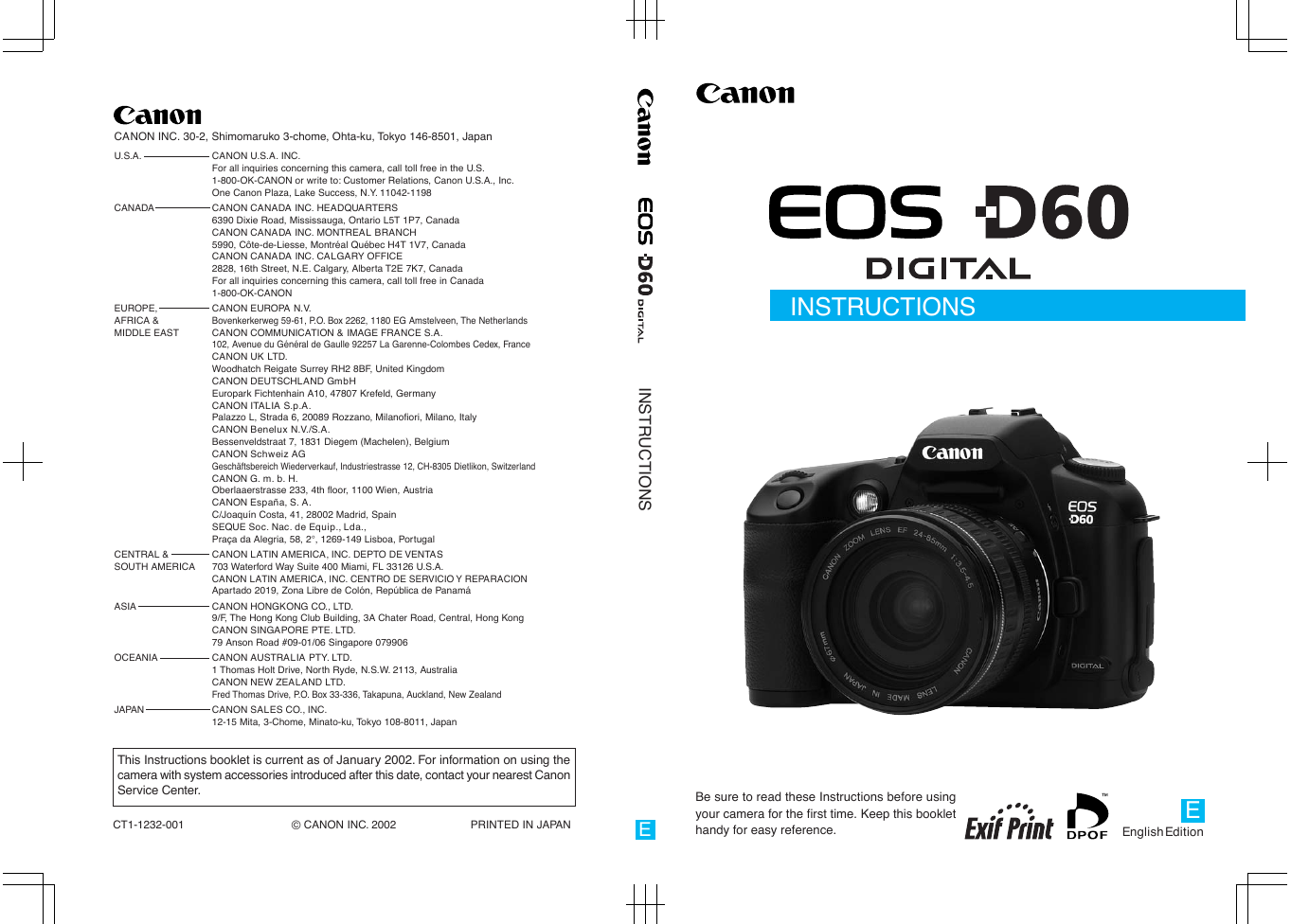
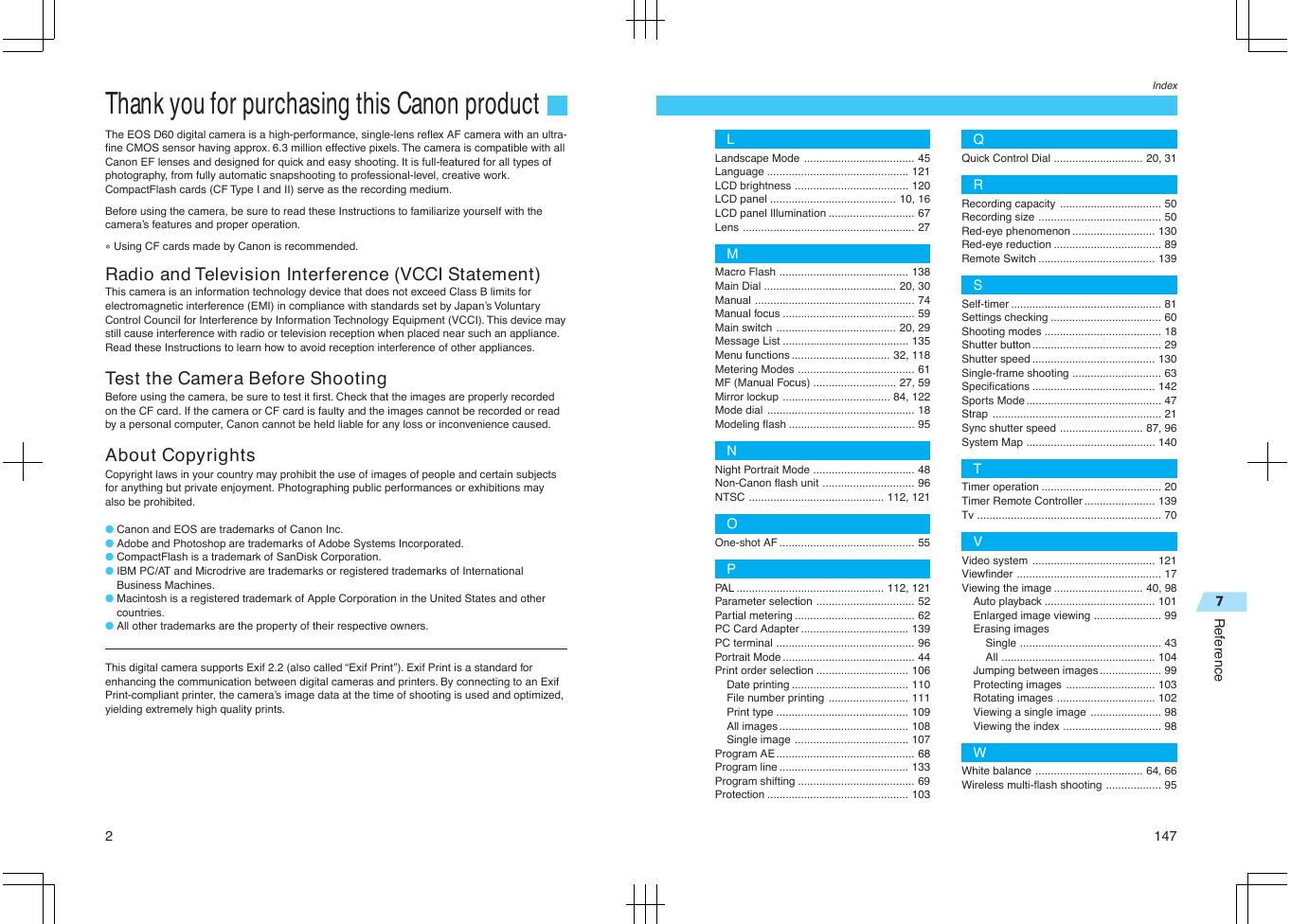

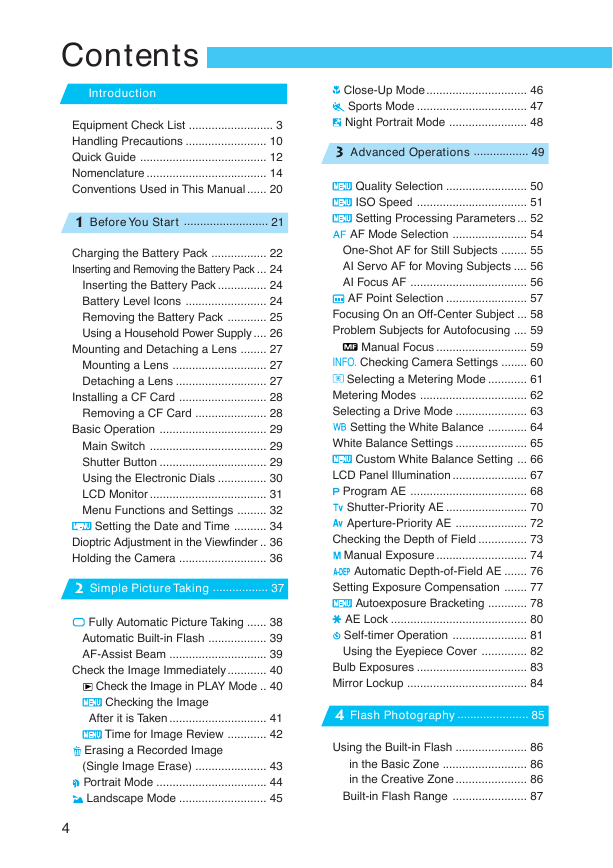
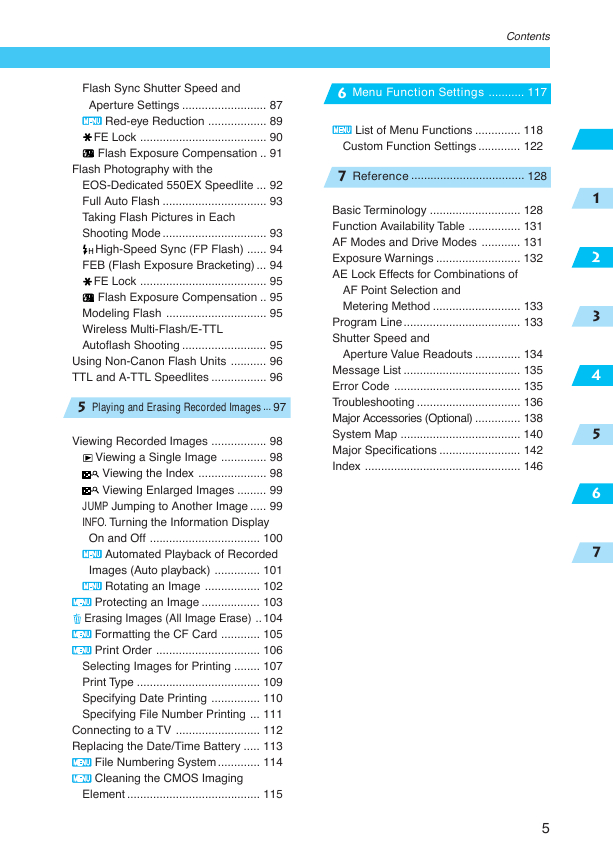
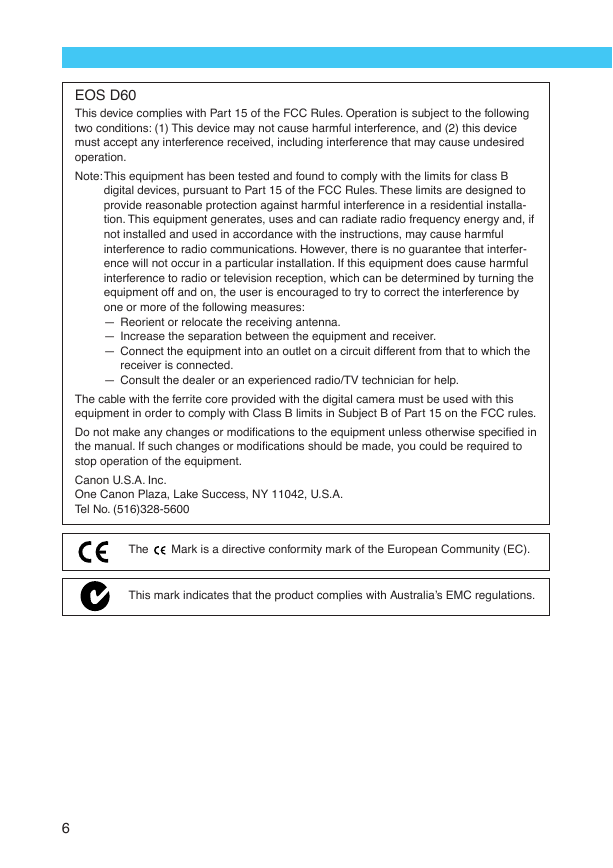

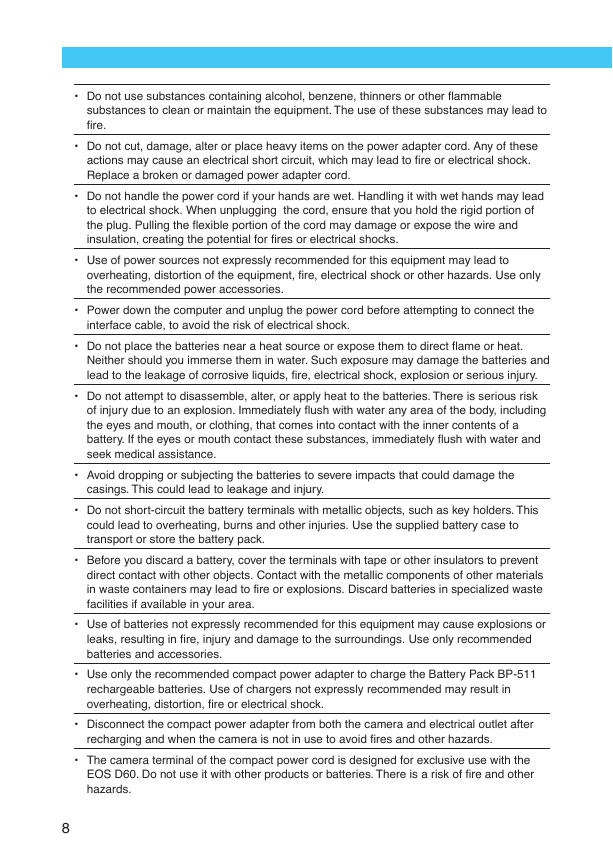








 2023年江西萍乡中考道德与法治真题及答案.doc
2023年江西萍乡中考道德与法治真题及答案.doc 2012年重庆南川中考生物真题及答案.doc
2012年重庆南川中考生物真题及答案.doc 2013年江西师范大学地理学综合及文艺理论基础考研真题.doc
2013年江西师范大学地理学综合及文艺理论基础考研真题.doc 2020年四川甘孜小升初语文真题及答案I卷.doc
2020年四川甘孜小升初语文真题及答案I卷.doc 2020年注册岩土工程师专业基础考试真题及答案.doc
2020年注册岩土工程师专业基础考试真题及答案.doc 2023-2024学年福建省厦门市九年级上学期数学月考试题及答案.doc
2023-2024学年福建省厦门市九年级上学期数学月考试题及答案.doc 2021-2022学年辽宁省沈阳市大东区九年级上学期语文期末试题及答案.doc
2021-2022学年辽宁省沈阳市大东区九年级上学期语文期末试题及答案.doc 2022-2023学年北京东城区初三第一学期物理期末试卷及答案.doc
2022-2023学年北京东城区初三第一学期物理期末试卷及答案.doc 2018上半年江西教师资格初中地理学科知识与教学能力真题及答案.doc
2018上半年江西教师资格初中地理学科知识与教学能力真题及答案.doc 2012年河北国家公务员申论考试真题及答案-省级.doc
2012年河北国家公务员申论考试真题及答案-省级.doc 2020-2021学年江苏省扬州市江都区邵樊片九年级上学期数学第一次质量检测试题及答案.doc
2020-2021学年江苏省扬州市江都区邵樊片九年级上学期数学第一次质量检测试题及答案.doc 2022下半年黑龙江教师资格证中学综合素质真题及答案.doc
2022下半年黑龙江教师资格证中学综合素质真题及答案.doc